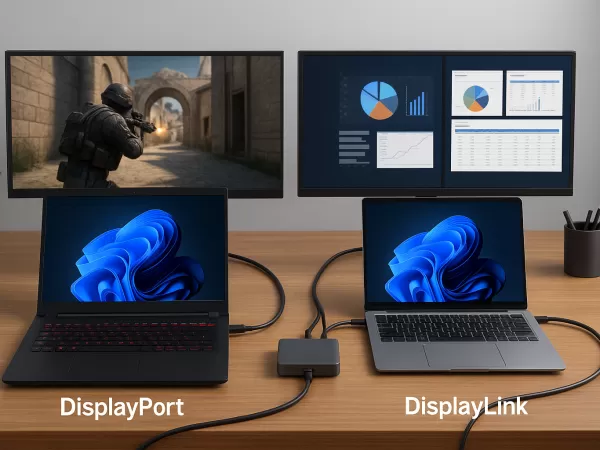DisplayPort vs. DisplayLink: Understanding the Core Logic Behind Two Distinct Display Technologies — A Wfyear Perspective

Why These Two Technologies Are Often Confused
When shopping for a gaming monitor, sales staff may recommend a model with DisplayPort. When searching for multi-screen expansion for an ultrabook, customer service might guide you toward a DisplayLink docking station.
Although both names contain “Display,” and “Link,” the underlying technologies are fundamentally different.
At Wfyear, where we develop docking stations, hubs, and display expansion solutions, helping users understand this distinction is essential for choosing the right product.
1. DisplayPort: A Dedicated High-Speed Highway for Native Video Output
Think of DisplayPort (DP) as a specialized high-speed expressway, designed exclusively for direct video transmission from the GPU to the monitor.
Key Advantages of DisplayPort
Native, uncompressed digital signals
Direct connection from GPU → monitor
High bandwidth, with DP 1.4 delivering up to 32.4Gbps
Supports 4K 144Hz, 8K 60Hz, and HDR
Compatible with adaptive sync technologies like G-Sync and FreeSync
True plug-and-play, no drivers required
For gamers, designers, and professionals demanding pixel-perfect accuracy + ultra-low latency, DisplayPort is the gold standard.
2. DisplayLink: A Smart, Flexible “Traffic Coordination System”
DisplayLink operates more like an intelligent traffic scheduling system built on software.
Instead of sending raw GPU output, DisplayLink:
Compresses the video signal at the host
Sends it over USB (not DP hardware)
Decompresses the signal at the docking station
This workflow requires a DisplayLink driver and introduces about 10–20 ms latency, but it unlocks unique advantages:
Why DisplayLink Is So Flexible
Runs over any USB-C/USB-A port
Supports multiple displays via a single cable
Can output to legacy interfaces (HDMI, DP, VGA)
Ideal for ultrabooks with limited ports
Perfect for multi-tasking environments where productivity > latency
This is why DisplayLink is known as the “Swiss Army Knife” of mobile productivity.
Wfyear products such as USB-C docking stations and multi-display hubs use this technology to provide plug-and-play multi-screen expansion for business users and hybrid work scenarios.
3. DisplayPort vs. DisplayLink: Which Should You Choose?
For Gamers & Creatives → Choose DisplayPort
Because:
Zero compression
Lowest latency
Best support for 144Hz, 165Hz, 240Hz
Smooth adaptive sync
Ideal for AAA gaming, e-sports, 3D modeling, video editing
For Mobile Professionals & Ultrabook Users → Choose DisplayLink
Because:
Multi-display support from a single USB port
Works even when laptops lack native DP or HDMI
Compatible with conference rooms, projectors, and diverse display setups
Great for productivity, coding, financial dashboards, and office workflows
4. Core Comparison Table (Optimized for Wfyear)
| Aspect | DisplayPort | DisplayLink |
|---|---|---|
| Technology Type | Hardware-level physical interface | Software-driven video transport |
| Transmission Path | Native GPU → Monitor (no compression) | Compression → USB → Decompression |
| Latency | Ultra-low | Moderate (10–20 ms) |
| Performance Factors | Cable quality & DP version | Driver, CPU load, USB bandwidth |
| Typical Use Cases | Gaming, design, high-refresh displays | Multi-screen expansion, mobile office |
| Driver Requirement | No | Yes |
| Best For | Performance-first scenarios | Flexibility-first scenarios |
 5. Breaking the Myth: These Are Not Competing Interfaces
5. Breaking the Myth: These Are Not Competing Interfaces
A common misconception is that DisplayPort and DisplayLink are two competing interface standards.
In reality:
DisplayPort focuses on raw performance and native bandwidth.
DisplayLink focuses on flexibility and multi-display scaling.
They solve different problems, serve different users, and often co-exist in the same ecosystem.
Conclusion: Choose Based on Core Needs — Performance or Flexibility?
If you want maximum gaming responsiveness or professional-grade color accuracy, the DisplayPort “high-speed highway” is your best choice.
If you need multi-display expansion, USB-based convenience, or a portable workstation, DisplayLink’s software-powered model offers unbeatable flexibility.
At Wfyear, our goal is to help you identify the right connectivity solution—from high-bandwidth DP adapters to DisplayLink-powered docking stations—so you always get the best performance for your workflow.